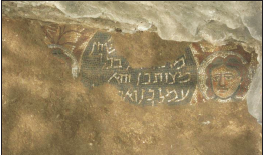
A mosaic that illustrates the Biblical story of Samson discovered in July
in Huqoq, Israel by an excavation team headed by the University of
North Carolina. Aransas Pass senior Brook Bonorden, a Baylor anthropology
major, contributed to the finding.
By Maegan Rocio
Staff Writer
Samson and … Brook?
Aransas Pass senior Brook Bonorden, an anthropology major, contributed to a historic find in Huqoq, Israel, this past July: the discovery of a mosaic that illustrates the biblical story of Samson. Bonorden was part of an excavation team headed by the University of North Carolina that included students and professors from other colleges across the nation.
Bonorden was one of the team members assigned to excavate the ancient village of Huqoq when the mosaic was first discovered.
“We first discovered one of the female faces depicted in the mosaic peeking out from the corner of the synagogue wall,” Bonorden wrote in an email to the Lariat. “Jodi, the dig director, came running down the hill to the ancient village yelling, “We found it!” Our whole team took off running to go see the mosaic.”
Bonorden was not the only Baylor affiliate to participate in the excavation. Art history assistant professor, Nathan Elkins served as the excavation team’s numismatist, or coin-finding specialist. Elkins was with the team when they discovered the mosaic, but he was not at the exact location of the find.
“I had been on site in previous days supervising the sifting operation and instructing field school students how to differentiate between different types of objects found in the sifter,” Elkins wrote in an email to the Lariat. “At this time we were finding small colored, tesserae, small, cubed-shaped stones, the building blocks for mosaics; this was an indication that we were going to find an a mosaic.”
Bonorden said the mosaic depicts a specific event in the Biblical story of Samson.
“The mosaic includes the depictions of the heads of two women, an illustration of the biblical hero Samson and two foxes with burning torches tied to their tails, as described in the Book of Judges when he set fire to the Phillistine’s crops, and a damaged Hebrew inscription urging congregants to perform good deeds,” she said.
The mosaic divulges historical information about the religious culture of Israel.
“The mosaic is among an increasingly large body of figural mosaics from ancient synagogues,” Elkins says. “We often think of Jewish religion being aniconic, prohibiting images in religious contexts, but archaeological and visual evidence suggest that ancient Judaism was very diverse. Mosaics depicting scenes from the life of Samson, the subject of Huqoq’s mosaic, are very rare. The Hebrew inscription on the mosaic encourages viewers to do good deeds, a theme that we are still very familiar with in the Judaeo-Christian tradition.”
Bonorden said the mosaic also offers insight into the economic status of Huqoq.
“When considering how detailed the mosaic is with very tiny tesserae, and the monumental size of the stones used to construct the ancient synagogue it lies within, one may draw assumptions that the ancient village found in association with
the synagogue demonstrated a high level of prosperity,” she said. “This assertion has been supported by the findings within the ancient village, which indicate that the village exhibited an agrarian-based economy with extensive trade.”
Bonorden said the mosaic remains in the synagogue, where it was discovered as part of the structure’s floor. However, to help preserve the artifact, Bonorden said the excavation team enlisted the help of conservator Orna Cohen, who is famous for conserving the “Jesus Boat” found in the Sea of Galilee.
Bonorden said despite the exciting discovery, there is still work to be done at Huqoq, and other Classical Near Eastern archaeologists will follow the team’s work in Huqoq.
“Dr. Jodi Magness plans to continue excavations at Huqoq for at least the next five years, and hopefully the potential findings during those field seasons will shed light on the age of the mosaic, which was Dr. Magness’ primary research question,” she said.
Dr. Magness was the dig director during the 2012 field season that Bonorden and Elkins






